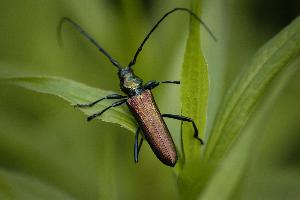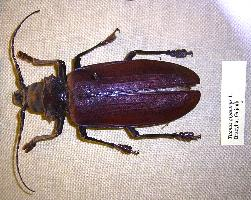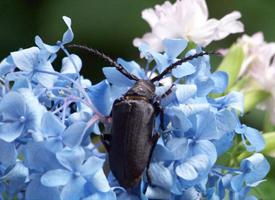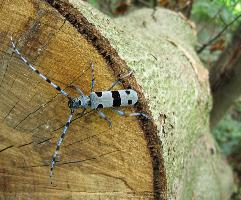
Súlyok és méretek
| Hossz | 13-tól 40-ig mm |
|---|
Állatleírás
The Musk beetle (Aromia moschata) is a captivating species of longhorn beetle, belonging to the family Cerambycidae. This fascinating insect is primarily known for its distinctive musky odor, from which it derives its common name. The scent is more pronounced in males and is believed to play a crucial role in attracting mates.Adult Musk beetles are quite large and visually striking, with body lengths ranging from 15 to 35 millimeters. They possess an elongated, slender body shape characteristic of many longhorn beetles. The coloration of these beetles is particularly eye-catching; their bodies exhibit a beautiful metallic sheen that can vary in hue from green to blue-green, and sometimes even shades of copper or violet under different lighting conditions. This iridescence not only makes them a marvel to observe but also serves as a form of camouflage among the foliage where they reside.
One of the most notable features of the Musk beetle is its long antennae, which can extend beyond the length of its body. These antennae are not just for show; they are highly sensitive organs that enable the beetle to navigate its environment, find food, and locate potential mates.
Musk beetles are primarily found in Europe and Asia, inhabiting deciduous forests, particularly favoring areas rich in willow, poplar, and birch trees. These trees serve not only as their habitat but also as a crucial food source for the larvae. The female Musk beetle lays her eggs in crevices in the bark of these trees, where, upon hatching, the larvae burrow into the wood. The larval stage is a critical period in the Musk beetle's life cycle, as the larvae feed on the wood, creating intricate tunnel systems. This process can take several years, during which the larvae grow and eventually pupate within the wood before emerging as adults.
The adult Musk beetle, although primarily a nocturnal creature, can often be seen basking in the sunlight during the day on tree trunks or leaves, absorbing the warmth needed to become active. Their diet mainly consists of nectar and pollen from a variety of flowers, making them important pollinators in their ecosystem.
Despite their beauty and ecological importance, Musk beetles face threats from habitat destruction and pollution. The loss of their natural habitats due to deforestation and urbanization poses a significant challenge to their survival. Additionally, the use of pesticides can have detrimental effects on their population, directly through poisoning and indirectly by reducing the availability of their floral food sources.
In conclusion, the Musk beetle is a remarkable insect, notable for its striking appearance, unique scent, and the intricate life cycle that ties it closely to the forests it inhabits. As with many species, understanding and protecting the natural habitats of the Musk beetle is crucial for its conservation and the preservation of the biodiversity of our planet's ecosystems.
Hasonló állatok
Új állatfotók
Top 10 állat
- Dolphin gull (Leucophaeus scoresbii)
- Japanese macaque (Macaca fuscata)
- Stone loach (Barbatula barbatula)
- Russian tortoise (Testudo horsfieldii)
- Galápagos tortoise (Geochelone nigra complex)
- Greek tortoise (Testudo graeca)
- Diana monkey (Cercopithecus diana)
- Common flying dragon (Draco volans)
- Moustached guenon (Cercopithecus cephus)
- Galápagos penguin (Spheniscus mendiculus)


